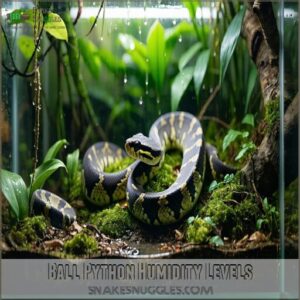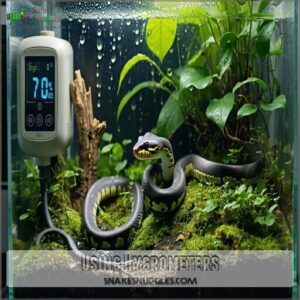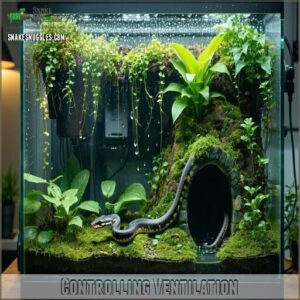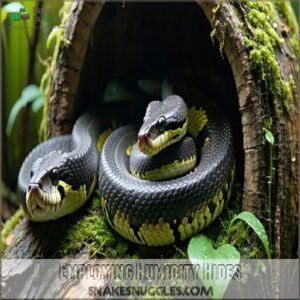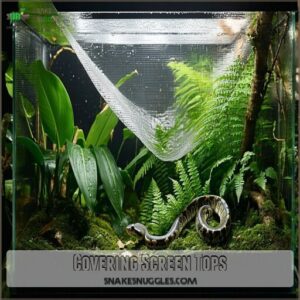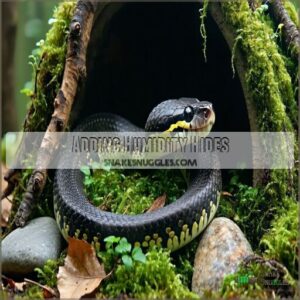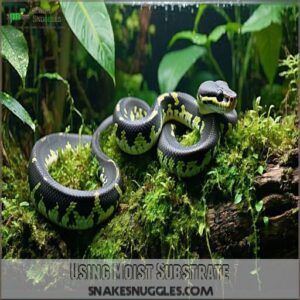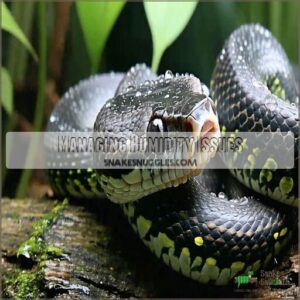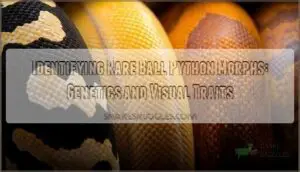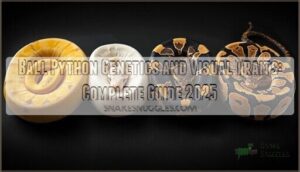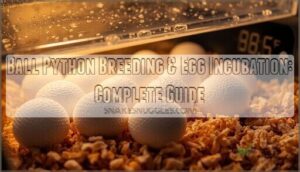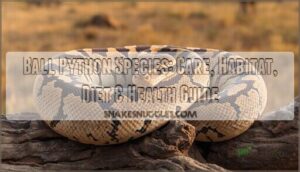This site is supported by our readers. We may earn a commission, at no cost to you, if you purchase through links.
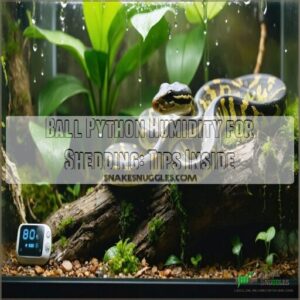 You’re wondering about the ideal ball python humidity requirements for shedding.
You’re wondering about the ideal ball python humidity requirements for shedding.
To keep your pet healthy, maintain a humidity level of 55-80%. Increase it to 80% during shedding to prevent stuck shed and dehydration. Use a hygrometer to monitor levels, and adjust as needed.
Proper humidity is important for a smooth shed cycle, so it’s important to get it right. Now, let’s explore how to create the perfect environment for your ball python’s next shed, and what other tips you can use to help your pet stay healthy and happy.
Table Of Contents
- Key Takeaways
- Ball Python Humidity Levels
- Maintaining Optimal Humidity
- Increasing Humidity Levels
- Humidity During Shedding
- Managing Humidity Issues
- Frequently Asked Questions (FAQs)
- What is a good humidity level for ball pythons?
- How to keep a ball python from shedding?
- Can a ball python shed if humidity is too low?
- Why does my ball python shed a lot?
- How humid should a ball python enclosure be?
- How do you maintain humidity in a ball python?
- What should the humidity be for a ball python shedding?
- What is the ideal humidity level for a shed?
- Is 80% humidity too high for a ball python?
- Can you leave a heat lamp on 24/7 for ball python?
- Conclusion
Key Takeaways
- You’ll want to maintain a humidity level of 55-80% for your ball python, with 60-70% being ideal for their comfort and health, and boost it to 80% during shedding to prevent stuck shed and dehydration.
- To keep your pet healthy, you’ll need to monitor humidity daily, avoid fluctuations, and ensure proper ventilation, as low or high humidity can cause shedding problems, respiratory infections, and other health issues.
- You can increase humidity levels by covering parts of the screen top, adding humidity hides with damp materials like sphagnum moss, and using a moist substrate to retain moisture and create a humid environment.
- It’s crucial to prevent humidity-related health complications, such as dehydration, bacterial growth, and fungal diseases, by adjusting humidity levels, using a digital hygrometer, and maintaining a clean and well-ventilated enclosure for your ball python.
Ball Python Humidity Levels
You’re about to learn how to get the humidity just right for your ball python, and it’s critical to understand that the ideal humidity range is between 55-80%.
You’ll need to maintain a humidity level of 60-70% for your pet’s overall health, and increase it to 80% when it’s shedding to prevent complications.
Ideal Humidity Range
To keep your ball python happy, maintain an ideal range of 40-60% humidity.
Low humidity can cause shedding problems.
Here are key points:
- Measure humidity daily
- Avoid fluctuations
- Monitor daytime and nighttime humidity, ideal for ball python shedding.
The key to success is to follow these guidelines carefully and ensure the humidity levels are appropriate for your pet.
Humidity Effects on Shedding
You’ll see shedding problems if humidity’s off.
| Humidity | Shedding | Health |
|---|---|---|
| Low | Stuck shed | Dehydration |
| High | Vision impairment | Infections |
Proper humidity for shedding is key to prevent issues.
Humidity and Respiratory Issues
Both low and high humidity can cause respiratory infections.
Too little humidity dries out their lungs, making it easy for germs to take hold.
Dehydration, not humidity spikes, causes respiratory infections in Ball Pythons.
Too much humidity creates a breeding ground for bacteria and fungi, also leading to respiratory infection.
Here’s what you need to know:
- Respiratory infections can be deadly.
- Pneumonia symptoms include wheezing and mucus.
- Humidity’s role is key for lung health.
- Bacterial growth thrives in high humidity.
- Fungal infections also love damp environments.
So, keep that humidity just right to prevent bacterial growth and fungal infections.
Maintaining Optimal Humidity
You’ll want to maintain ideal humidity for your ball python, as it’s important for their shedding process and overall health.
To do this, you’ll need to control ventilation, use hygrometers, and employ humidity hides to keep the environment just right for your pet.
Using Hygrometers
You’ll use a hygrometer to monitor ball python humidity.
You can find accurate reptile hygrometers for sale online.
| Hygrometer Type | Placement | Accuracy |
|---|---|---|
| Digital | Center | High |
| Analog | Side | Medium |
| Digital | Corner | Low |
Choose a digital hygrometer for accurate readings.
Controlling Ventilation
You adjust ventilation by covering your screen top, allowing for airflow and cross ventilation.
Proper airflow is key, so consider enclosure placement and tank ventilation for effective air exchange, making ventilation adjustments as needed to maintain the right environment.
For more detailed guidance, explore effective snake terrarium humidity control, which can help with effective air exchange and understanding the importance of proper airflow.
Employing Humidity Hides
Create a humidity hide with damp moss to help your ball python shed smoothly, placing it in a spot where your pet likes to curl up.
Monitor humidity levels to prevent shedding humidity issues, ensuring the hide is clean and the right size for your snake’s comfort.
Specialty humidity hide products are also available commercially to aid in creating an ideal environment for your ball python.
Increasing Humidity Levels
You’re looking to increase the humidity levels for your ball python, especially during shedding.
To do this, you’ll need to cover parts of the screen top, add humidity hides with moist materials, and use a moist substrate to retain moisture and create a humid environment.
Covering Screen Tops
You’ve got your hygrometer, now let’s talk screen tops. One way to boost humidity is by covering part of the screen top. Think of it like putting a lid on a pot to keep the steam in.
- Cardboard
- Plastic wrap
- Towels
- Aluminum foil
Partial covering helps with humidity retention by limiting ventilation reduction. Be mindful of temperature impact; covering too much can make it too hot! Experiment to find the right balance for humidity control, increasing humidity without overheating.
This simple trick can make a world of difference for your slithery friend!
Adding Humidity Hides
You’ll add humidity hides to increase moisture.
Choose materials like damp sphagnum moss for your DIY humidity hide, considering hide size and placement for effective humidity monitoring.
Helping prevent shedding problems in your ball python is crucial, and using a humidity hide made from the right materials, such as damp sphagnum moss, can be very effective.
Using Moist Substrate
You’ll want a substrate with good moisture retention, like sphagnum moss or cypress mulch, to help control humidity and prevent mold.
For more options, review this guide on safe snake substrate humidity.
These substrate types are great options for maintaining ideal humidity levels and keeping your ball python healthy.
Humidity During Shedding
You’ll want to increase the humidity in your ball python’s enclosure when it’s shedding to help the process go smoothly.
By keeping the humidity level right, you can prevent stuck shed and other problems, and make sure your snake stays healthy and happy.
Temporary Humidity Increase
You’re increasing humidity levels, now consider a temporary humidity increase to 70% as a shedding aid.
- Adjust timing
- Control duration
- Use localized humidity
- Monitor humidity return
- Prevent low humidity shedding problems
Humidity Hide Boxes
You’ll use a humidity hide box to maintain humidity.
Many keepers utilize ball python humidity hides for this purpose.
| Material | Size | Placement |
|---|---|---|
| Sphagnum | Small | Corner |
| Coco coir | Medium | Center |
| Moss | Large | Against wall |
Clean it regularly to prevent bacterial growth.
Preventing Stuck Shed
You’re using humidity hide boxes, now prevent stuck shed with:
- Proper hydration
- Increased humidity
- Gentle shedding aid, to avoid shedding problems and stuck shed causes, ensuring a smooth ball python shedding process with effective humidity solutions.
Managing Humidity Issues
You’re taking the right steps to manage your ball python’s humidity levels, and now it’s time to tackle any issues that may arise.
By monitoring and adjusting the humidity in your snake’s enclosure, you can prevent health complications and guarantee a safe, comfortable environment for shedding.
Decreasing Humidity
To decrease humidity, increase ventilation by uncovering screen tops or using a drier substrate type, and reduce water dish size to lower humidity and prevent humidity problems in your ball python’s tank.
This approach ensures proper air circulation and avoiding high humidity issues, which is crucial for the health of your snake.
Proper snake terrarium humidity control is important for a healthy snake.
Monitoring Humidity
After adjusting your ball python’s humidity, keeping an eye on it’s key. A digital hygrometer is your best friend here.
- Place your hygrometer front and center in the enclosure.
- Consistent monitoring helps you spot humidity fluctuations.
- Some hygrometers offer data logging – a handy feature!
Remember seasonal adjustments; what works in summer mightn’t work in winter. A humidity gauge will tell you what’s up.
Preventing Health Complications
You monitor humidity to prevent stuck shed risks, respiratory infections, and scale damage.
| Humidity | Issue | Prevention |
|---|---|---|
| Low | Dehydration | Increase humidity |
| High | Bacterial growth | Decrease humidity |
| Incorrect | Fungal diseases | Adjust humidity |
| Incorrect | Shedding problems | Monitor humidity |
The table outlines specific prevention measures for different humidity levels, including low, high, and incorrect humidity, to address issues such as dehydration, bacterial growth, fungal diseases, and shedding problems.
Frequently Asked Questions (FAQs)
What is a good humidity level for ball pythons?
You’ll want a humidity level between 55-80% for your ball python, with 60-70% being ideal for their comfort and health, preventing dehydration and shedding issues.
How to keep a ball python from shedding?
You can’t stop a ball python from shedding, but promoting ideal humidity and temperature helps ensure a healthy shed, reducing risks of stuck skin and related health issues naturally.
Can a ball python shed if humidity is too low?
You’ll struggle to shed properly if humidity is too low, leading to stuck shed, especially around the eyes, and potential vision problems or blindness in your ball python.
Why does my ball python shed a lot?
Are you wondering why your ball python sheds a lot? It’s likely due to low humidity, causing dehydration and shedding issues, so increase humidity to 60-80% for a healthier shed.
How humid should a ball python enclosure be?
You should keep your ball python’s enclosure humidity between 55-80%, ideally 60-70%, to prevent dehydration and shedding issues, and promote healthy growth.
How do you maintain humidity in a ball python?
You maintain humidity in a ball python’s enclosure by using a hygrometer, misting daily, and employing humidity hides with damp materials like sphagnum moss.
What should the humidity be for a ball python shedding?
You should increase humidity to 70-80% when your ball python sheds to aid the process and prevent issues like stuck shed, ensuring a healthy and stress-free experience for your pet.
What is the ideal humidity level for a shed?
You’ll want to bump up the humidity to around 70-80% when your ball python is shedding to help it slip out of its skin more easily and comfortably.
Is 80% humidity too high for a ball python?
You’ll find 80% humidity is perfect for shedding, but it’s too high for daily life, as it can foster bacterial and fungal growth, so balance is key for your pet’s health.
Can you leave a heat lamp on 24/7 for ball python?
You shouldn’t leave a heat lamp on 24/7 for your ball python, as it can cause overheating and stress, so use a thermostat to regulate the temperature safely.
Conclusion
You’re now a ball python humidity master, capable of creating a shed-tastic environment.
Remember, maintaining the right ball python humidity requirements for shedding is important, so keep it between 55-80% and boost it to 80% during shedding to prevent stuck shed and dehydration.
Ensuring your pet stays happy and healthy with perfect ball python humidity requirements for shedding is crucial.
- https://www.worldofballpythons.com/python-regius/care-sheet/
- https://reptifiles.com/ball-python-care-guide/ball-python-humidity-temperatures/
- https://www.everythingreptiles.com/ball-python-humidity/
- https://mypetpython.com/ball-python-shedding-process/
- https://www.reptileknowledge.com/care/ball-python-humidity.php

